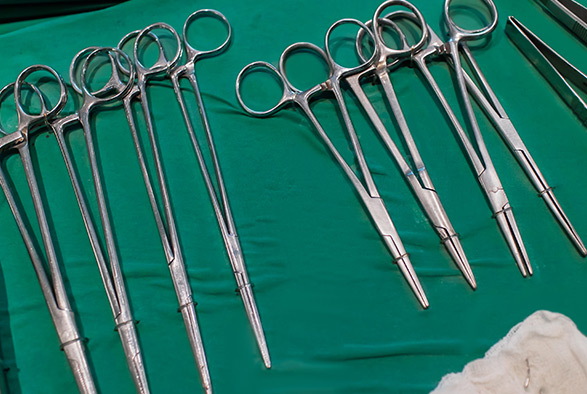Breast augmentation, also known as breast enlargement, is one of the most commonly performed plastic surgery procedures in the United States. Through the installation of saline or silicone breast implants, breast augmentation restores volume that may have been lost following weight loss or pregnancy, giving you fuller-looking breasts and increased self-confidence. Breast augmentation does not correct severely drooping breasts; in this case, a better option may be a breast lift with or without breast augmentation.

There are several different types of breast implants, but the two broad breast implant categories are silicone and saline.
Saline breast implants are filled with sterilized salt water and can be filled with various amounts of saline to fine-tune the breast’s firmness, shape, and feel. If the implant ever leaks, the saline liquid will be absorbed by the body and expelled naturally.
Silicone breast implants are filled with a silicone gel that better mimics the feel and movement of natural breast tissue. These types of breast implants are pre-made and are larger than a saline breast implant, requiring a larger incision. If a silicone breast implant leaks, the gel may leak into the implant cavity; since this may not be noticeable, a yearly MRI is recommended to assess the condition and integrity of the implant. Our plastic surgeon will work with you to determine which type of breast implant is best for you.
It is important to understand that both saline and silicone breast implants may need to be replaced over time. The results are not permanent, and changes can affect the look and feel of your current implants. Weight gain or loss, age, gravity, and certain hormonal factors can change the appearance of your breasts. Should any of those occur, a breast implant exchange and/or a breast lift may be considered.
Silicones are a family of chemical compounds made from silicon, a naturally occurring element found in sand and rock that becomes silicone when combined with oxygen, carbon and hydrogen (next to oxygen, silicon is the most common element in the earth’s crust). Silicones have been used for over 50 years in products like hairspray and moisturizing creams, as well as medical devices such as artificial joints, catheters, and facial implants.
The FDA’s decision to approve silicone-filled breast implants is good news for patients looking to improve the appearance of their breasts, says Dr. Barone. For one thing, it gives women an option over saline-filled implants. “All breast implants are made from a solid silicone rubber shell that’s filled with either saline solution (sterile salt water) or elastic silicone gel,” she explains. There are advantages and disadvantages to both types, but, generally speaking, silicone implants just look and feel more natural, Dr. Barone says.
Silicone gel is viscous, she says. “It has a thick, sticky consistency that’s a lot like human fat, which is a large component of female breast tissue.” On the other hand, saline solution isn’t compressible, so it looks – and feels – firmer. “Saline implants can feel like water balloons,” she explains. And the bigger the implant, the more that becomes a problem.
Of course, as with any other medical device or surgery, breast implants are not without risk, Dr, Barone stresses. “Any man-made device has a finite life span,” she says. “It may need to be replaced, and it can tear, although that possibility is rare.” If a saline- filled implant ruptures, the implant will deflate and the water will be absorbed harmlessly by the body. If a silicone implant ruptures, the gel may remain within the shell or rarely escape into the breast. (Today’s silicone-filled implants are less likely to rupture than earlier models, thanks to a multi-layer shell.) “If your silicone implant breaks or leaks, you might not be aware of it,” Dr. Barone cautions. For that reason, you should have an ultrasound exam or MRI screening every year to assess the condition of your implants. And just as you would if you didn’t have implants, you also should practice a monthly breast self-exam and schedule regular diagnostic breast screenings.

Several incision options exist for breast augmentation surgery; these options include the periareolar incision, the inframammary incision, and the transaxillary incision.
The periareolar incision is made around the edge of the areola. This approach leaves the least conspicuous breast augmentation scars, as they are hidden between the coloring of the areola and the breast skin. A periareolar incision may affect a woman’s ability to breastfeed in the future as it divides the milk ducts. Nevertheless, this approach is still commonly used, as women planning to have more children are advised to postpone breast augmentation.
The inframammary incision is considered the fastest and simplest of the three incision options, involving an incision across the lower fold of the breast. This approach is ideal for patients with fuller breasts that will effectively cover the scar. The shortcoming of the inframammary incision is that breast augmentation scars may be noticeable when lying down.
The transaxillary incision involves an incision in the armpit through which the implants are guided to the breasts. With this option, the scars are on the armpits and not on the breasts themselves. The downside to the transaxillary incision is that the plastic surgeon is operating farther from the breasts, increasing the likelihood that the implants are improperly placed. When performed by a trained plastic surgeon, the transaxillary incision is an excellent option for breast augmentation patients who want the scars hidden on their armpits.

Patients considering breast augmentation must be in good overall health. Their breasts may have decreased in size and/or firmness following childbirth or weight loss, are noticeably asymmetrical, or have always been too small. Patients undergoing breast augmentation surgery are usually unhappy with the small size of their breasts and feel self-conscious when wearing form-fitting tops or swimwear.
Before undergoing breast augmentation surgery, your plastic surgeon will examine your breasts, review your medical history, and address any concerns you may have about the procedure.
Medical photographs may be taken to compare the size of your breasts before and after surgery.
During the examination, the size and shape of your breasts, the location of your nipples and areolas, and other details will be noted; these details will determine the most appropriate type of breast implants and surgical incisions for your body type.
Notify your plastic surgeon of all medications you are currently taking, as some may need to be temporarily stopped before the procedure.
Patients who smoke will need to stop several weeks before surgery, as it may interfere with the body’s natural healing process.
Breast augmentation should be postponed if you are planning to become pregnant or lose weight, as these can unpredictably affect the size of your breasts.
For more information about breast enlargement, please visit our offices located in Manhattan, Bergen County, Long Island, Queens, and more.

Breast augmentation is usually performed as an outpatient procedure in a hospital, ambulatory center, or office-based surgical suite.
Patients are typically given a combination of local anesthesia and intravenous sedation; in some cases, general anesthesia may be used. After the anesthetic has taken effect, incisions are made, and the breast implants are inserted. Once the implants have been inserted, the incisions are shut with sutures in the breast tissue and surgical tape, stitches, or sutures over the skin. Breast augmentation surgery generally takes one to three hours.

The results of breast augmentation are noticeable immediately, and patients usually return home the same day as their procedure.
You may experience bruising, swelling, soreness, or pain during breast augmentation recovery. The symptoms can be managed with painkillers and should subside within a few weeks.
If non-absorbable stitches are used, they will be removed a few days after surgery.
Regular activity may be resumed within a few days after breast augmentation. However, physical activity should be avoided for a few weeks to give the breasts time to heal and adjust to the implants.
A skilled and experienced plastic surgeon can significantly minimize breast augmentation scars.

As with all surgical procedures, breast augmentation carries a risk of complications. These risks include adverse reactions to the anesthesia, capsular contracture, infection, and changes in nipple or breast sensation.
If you are going for a mammogram, let your technician know that you have breast implants, as they may require a more detailed examination. To minimize the occurrence of complications, always choose a board-certified plastic surgeon for your breast enlargement procedure and follow all instructions closely.

Breast augmentation surgery costs include the surgeon’s fee, anesthesia fee, operating room resources, and other associated expenses.
For a detailed estimate of your total breast augmentation price, book your consultation today by speaking with our consultation specialist. During your visit, you can also view before and after breast augmentation results to better understand the potential outcomes.
To find out if breast augmentation is right for you, contact us to schedule a consultation with our board-certified plastic surgeon. Our offices are conveniently located across Queens, NY, Long Island, NY, and Bergen County, NJ.

Receive skincare tips, news and special offers!